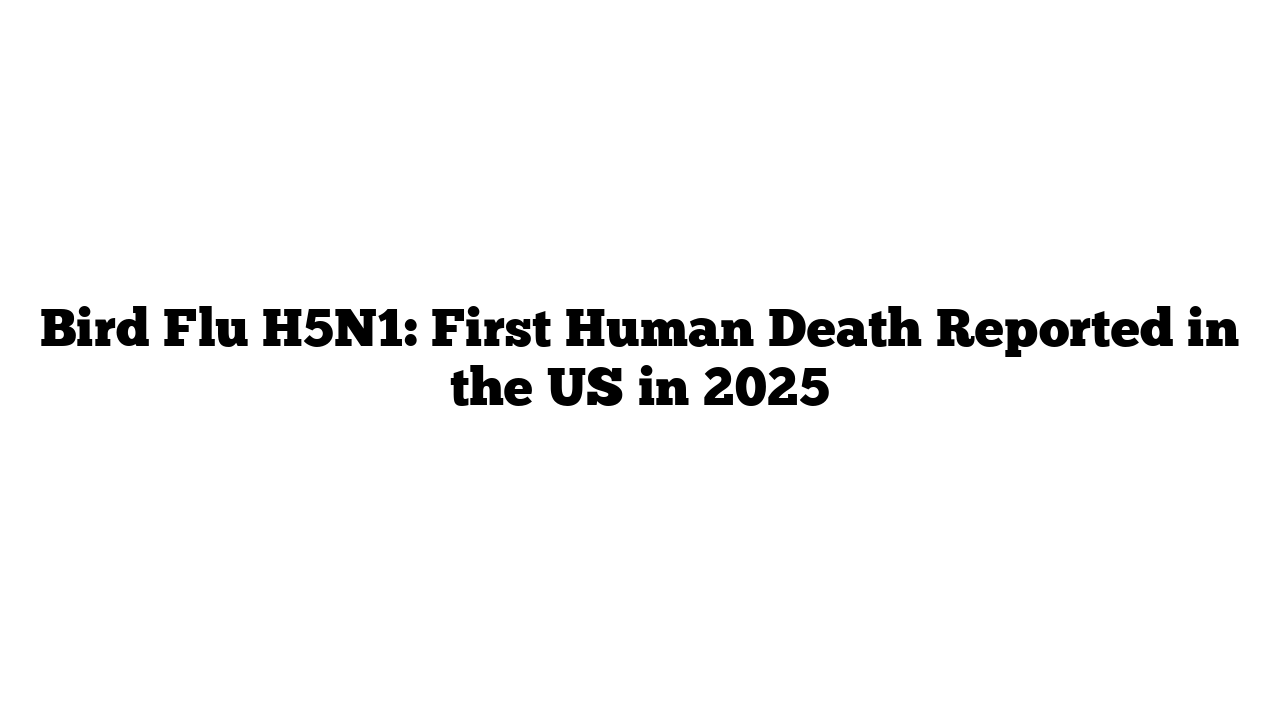Understanding Bird Flu and the First US Death from H5N1 Virus
The USA recently reported its first human death from the H5N1 virus, marking a significant moment in the global monitoring of bird flu.
This tragic incident in 2025 has raised concerns about the virus’s potential to impact human health further.
What is Bird Flu (H5N1)?
A Brief Overview
Bird flu, also known as avian influenza, is caused by influenza type A viruses that primarily affect birds but can occasionally infect humans. The H5N1 strain is one of the most well-known and dangerous types, with a high mortality rate among infected humans.
Why is H5N1 Concerning?
- High Mortality Rate: Over 50% of reported human cases have resulted in death worldwide.
- Global Spread: The virus has spread through bird populations across continents, raising the risk of human exposure.
- Pandemic Potential: Although human-to-human transmission is rare, mutations could increase this risk.
The First US Death from H5N1
What Happened?
In 2025, the United States reported its first human fatality from the H5N1 virus. The individual had close contact with infected poultry, a common transmission route for bird flu.
Implications of This Case
- Increased Vigilance: Health authorities are monitoring for further cases.
- Public Concern: Awareness campaigns are being launched to educate people about prevention.
How Does Bird Flu Spread?
Transmission in Birds
H5N1 spreads rapidly among wild birds and poultry through:
- Direct contact
- Contaminated water sources
- Droppings and feathers
Transmission to Humans
Humans can contract the virus through:
- Close contact with infected birds or their droppings.
- Handling contaminated surfaces like cages or farm equipment.
- Consumption of undercooked poultry or eggs from infected birds.
Symptoms of H5N1 in Humans
The symptoms of H5N1 infection can vary but often include:
- Fever
- Cough
- Sore throat
- Muscle aches
- Difficulty breathing (in severe cases)
- Pneumonia
These symptoms can escalate quickly, requiring immediate medical attention.
How Dangerous is Bird Flu in 2025?
Global Impact
The H5N1 virus has caused outbreaks worldwide, including in Asia, Europe, and now the USA. Millions of birds have been culled to prevent its spread, disrupting the poultry industry.
Human Health Concerns
While human cases remain rare, they are severe, with a high fatality rate. Experts worry about the virus mutating into a form that spreads easily among humans.
Prevention Measures for Bird Flu
For the General Public
- Avoid handling sick or dead birds.
- Cook poultry and eggs thoroughly.
- Wash hands frequently, especially after handling raw poultry.
For Farmers and Poultry Workers
- Wear protective gear when working with birds.
- Regularly disinfect equipment and facilities.
- Report any unusual bird deaths to local authorities.
Vaccines and Treatments
While there is no specific vaccine for humans against H5N1, antiviral medications like oseltamivir (Tamiflu) and zanamivir can help reduce symptoms and improve outcomes.
How is the USA Preparing for Bird Flu in 2025?
- Enhanced Surveillance: Monitoring bird populations and human cases closely.
- Public Awareness: Campaigns to educate people about symptoms and prevention.
- Research: Efforts to develop vaccines and better treatments.
Bird Flu vs. Other Influenza Viruses
How is H5N1 Different from Seasonal Flu?
- Transmission: Seasonal flu spreads easily between humans, while H5N1 rarely does.
- Severity: H5N1 infections are more severe and have a higher fatality rate.
- Prevention: Seasonal flu has effective vaccines, but H5N1 does not.
Trusted Resources for Bird Flu Information
For detailed insights and prevention tips, visit medicaltimes.io. Here are additional trusted sources:
- Centers for Disease Control and Prevention (CDC) (cdc.gov)
- World Health Organization (WHO) (who.int)
- U.S. Department of Agriculture (USDA) (usda.gov)
FAQs: Frequently Asked Questions
1. What is H5N1 bird flu?
H5N1 is a type of bird flu virus that can infect birds and, in rare cases, humans.
2. How did the first US death occur?
The individual likely contracted the virus through close contact with infected poultry.
3. Is bird flu contagious between humans?
Human-to-human transmission of H5N1 is extremely rare.
4. Can eating chicken cause bird flu?
Properly cooked poultry and eggs are safe to eat and do not spread bird flu.
5. What are the symptoms of H5N1 in humans?
Fever, cough, difficulty breathing, and pneumonia are common symptoms.
6. How can I protect myself from bird flu?
Avoid contact with sick birds, wash your hands, and cook poultry thoroughly.
7. Is there a vaccine for H5N1?
There is no widely available vaccine for humans, but research is ongoing.
8. How does H5N1 affect the poultry industry?
Outbreaks lead to the culling of millions of birds, causing economic losses.
9. Why is bird flu dangerous in 2025?
The potential for mutation and human transmission makes it a public health concern.
10. Where can I learn more about bird flu?
Visit medicaltimes.io and trusted sites like the CDC and WHO.
